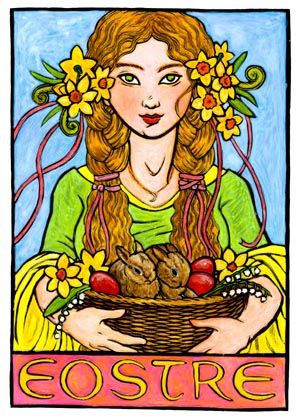For many, dyeing Easter eggs is an annual tradition and a way to spend quality time with family and friends before the Easter holiday. I’ve always wondered how the tradition of making and hiding colored eggs relates to Easter besides getting children more involved in the holiday festivities. So why do we dye eggs for a holiday that celebrates the resurrection of Jesus?
Upon making a quick web search, I was inundated with information about tons of different theories and origin stories about this tradition. While no one seems to know for sure which one is the most true – some being perhaps completely fictional – these stories cover a wide range of cultural backgrounds and geography. Some have more history behind them while others seem like stories passed down as a way to try to explain the tradition.
Perhaps one of the most common theories is that Easter was originally celebrated as a pagan holiday in different areas around Europe, celebrating the coming of spring and, in Anglo-Saxon England, the goddess Eastre.
In an attempt to get more people to convert to Christianity, missionaries turned this festival into a Christian holiday by turning a celebration about the resurrection of nature into a celebration of the resurrection of Christ, however they kept some of the elements of the original festivals so there would be a sense of familiarity for new converts. One of these elements was the importance of eggs, which were symbols of fertility, life and growth. The eggs would be served to eat or buried in the ground during these celebrations.
According to this story, it wasn’t until King Edward I of England supposedly ordered 450 colored and golden eggs to give out to his nobility in the year 1290 that colored eggs began to become a part of Easter festivities. It wasn’t until the Victorian period several hundred years later that dyeing and hiding eggs became a more family-oriented affair, bringing in the image of the Easter Bunny to the holiday and beginning the American tradition of the annual White House Easter
Egg Roll.
Another story originated in Ukraine where eggs were again associated with growth and life because of the yolk’s resemblance to the sun and the new life that forms inside. Each spring, people would write on eggs using beeswax and dye them to reveal patterns, typically resembling a sun or simply consisting of lines and triangles. This practice is known as pysanky, and was carried over to Christian Easter celebrations when missionaries arrived. Pysanky is a tradition that is still around today, and there are some people who can create beautifully intricate designs in a multitude of vivid
colors.
Some stories date the practice of dyeing eggs back to the days of the early Christian church and before. One theory states that Mesopotamian Christians would dye eggs red to symbolize the blood Jesus shed on the cross, another that Jesus’ mother Mary brought eggs with her to Jesus’ crucifixion site and that either his blood or her tears turned the eggs red.
One of my favorite stories tells of Mary Magdalene telling Emperor Tiberius that Jesus has risen. Tiberius scoffs and gestures to an egg in front of him, saying that Jesus is as alive as the egg is red. With his words, the egg immediately changed color to a brilliant crimson, proving that Jesus was, in fact, alive again. Though the different stories may differ in laying claim to the beginning of this tradition, there is a common thread of hope through them all, and ultimately through symbolism, a focus on the reason for the season:
resurrection.
Sources: Country Living, TIME, Mental Floss

